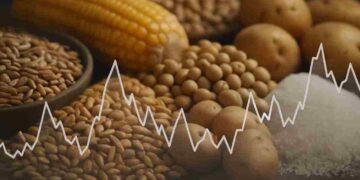Indonesia Stockpiles Record Reserves While India, Pakistan Face Policy and Climate Headwinds
Rice prices have plunged to three-year lows across Asia as leading producers ramp up harvests and market dynamics shift dramatically across major exporting and importing nations. Despite the price dip, experts warn of hidden volatility driven by geopolitical risks, policy changes, and monsoon uncertainties.
Market Overview
FOB offers for Asian 5% broken rice have fallen to US $410/t, their lowest levels since 2022. India’s removal of its last 2022 export restriction in March and Vietnam’s strong Mekong Delta harvest have flooded markets. Meanwhile, Thailand’s rice faces a 36% U.S. tariff threat, forcing potential discounts or government-to-government deals to maintain export targets.
Key Market Movements
India: Posted a record 136.4 million tonnes of milled rice in 2025 due to strong Kharif and Rabi crops. Despite this, the Food Corporation of India is easing stocks via OMSS auctions and ethanol redirection. Indian Basmati exports surged 15% in volume and 22% in value, reaching 5.24 million tonnes in FY2023/24. The premium segment is expected to hit US $31.6 billion by 2027.
Indonesia: Built rice reserves to an all-time high of 3.7 million tonnes via army-led procurement. 2025 production is forecast at 34.6 million tonnes, up 4.8% YoY. Jakarta is now considering limited exports for the first time in over a decade.
Vietnam: Expecting steady 2024/25 output of 26.5 million tonnes with stable rainfall. Vietnam’s 5% broken rice now trades at a near five-year low due to oversupply.
Pakistan: Facing reduced sowing due to water conservation mandates in Punjab and drought risks in Sindh. These restrictions may pressure output from the projected 9 million tonnes.
Thailand: Production stable around 20 million tonnes. However, a strong baht and tariff risk in the U.S. threaten the 7.5 million-tonne export goal.
Trade and Tariff Landscape
- Malaysia is seeking alternative suppliers due to India-Pakistan tensions, potentially shifting demand to Vietnam, Thailand, and Cambodia.
- The EU and India are negotiating pesticide MRLs that may influence premium Basmati flows.
- U.S. tariff threats on Thai rice may reroute up to 1 million tonnes of trade.
Price Signals & Forecast
- Indian PR-11 steam: $0.60/kg FOB
- Vietnamese 5% white: $0.65/kg FOB
- Indian 2-year aged Basmati: $2.21/kg FOB
- Base case projects 5% broken to stay between $400-420/t through September.
- Upside risk to $450/t if India sees a 10% monsoon shortfall.
Strategic Advice
Buyers: Secure Vietnamese 5% broken now; avoid Thai offers until tariff clarity. Book aged Basmati amid limited aging capacity.
Sellers: Promote organic/low-residue lines in the EU. Blend lower-end cargoes for value-sensitive markets.
Investors: Track Indonesia’s export potential and currency swings for arbitrage. A 500,000 t shift could reprice Southeast Asian supply.
Conclusion
Despite price softness, the rice market remains on alert. With India and Indonesia at production highs, and potential policy disruptions in Thailand and Pakistan, volatility is likely to persist. Strategic buying and risk management remain key through Q4 2025.
Export Perspectives:
- Exporters: India, Vietnam, Thailand, Pakistan, USA
- Importers: Malaysia, Philippines, China, Nigeria, UAE, Saudi Arabia
- Export Values: India Basmati exports at 5.24 Mt, valued +22% YoY; Vietnam and Thai 5% broken at ~$410/t
Top Competitor Producers: India and Vietnam dominate; Thailand and Pakistan face policy hurdles
Latest Stats: Indonesia production up 4.8% YoY; Vietnam 5% broken at 5-year lows; Indian PR-11 steam at $0.60/kg FOB












